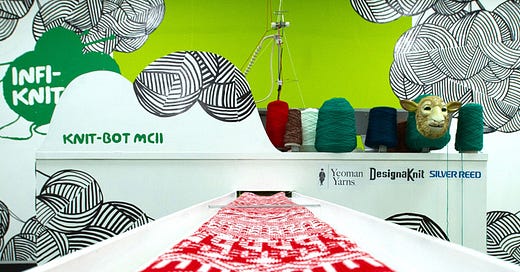Heads Up: What makes you feel warm?
Petitions. They’re a cornerstone of our movement. But how do stop them feeling like just another-online-petition?
The Brief: Macmillan Cancer Support aimed to raise awareness about the issue of fuel poverty affecting people fighting cancer. The charity sought to bring about legislative changes to ensure better heating solutions for vulnerable people. They had briefed an agency to help them create a petition.
The Campaign: Laura Jordan Bambach, owner of the hired agency, retells the story in a compelling marketing podcast. She recalls Macmillan hiring them to run a petition on a tight budget. She and her team wanted to push the boundaries of what was possible by re-thinking what a petition can be, without spending a lot of money.
What they eventually created was a stunning visual spectacle—a 64-foot tall knitted scarf that captured the public's imagination, the longest knitted petition ever created.
The campaign invited people to participate by answering the question, "What makes you feel warm?" These personal messages were then woven into the scarf using an automatic knitting machine, with a live video feed showcasing the process in real-time. The machine (and live feed) ran 24 hours a day, for 3 months.
https://laurajb.com/macmillan
The campaign successfully attracted media coverage, raising significant awareness and prompting discussions about the need for action. Notably, the campaign led to advocacy efforts that influenced the UK government to implement changes related to support for those fighting cancer and struggling to heat their homes.
To date, this still stands as Macmillan’s most successful campaign (conducted in 2011), not only due to the legislation change, but in new donors and supporters of their work.
Why does it stand out?
➡ The message vehicle was directly relevant to the message (heat > a scarf) making it a powerful metaphor
➡ The campaign structure, with the live feed, built a narrative over time, with varied ways to engage. This helps build an audience before the action moment of delivering the ‘petition’.
➡ It turns a petition into something concrete, a physical object and makes the message harder to ignore and more likely to pick up press attention.
We use petitions a lot. Most often digitally. But I wonder if there are more exciting ways to bring them to life and therefore increase their exposure and ability to generate conversation.
Heads Up Challenge: How can we make a petition come to life?
(Copy the below into a working document that you can use for the challenge each week)
Think of creative ways to take a standard petition campaign and bring it to life in a surprising way.
Your Brief:
Idea 1:
Idea 2:
Idea 3:
Set aside a weekly 15 minute slot to complete these weekly creative tasks and why not schedule a call with others on your team to talk through your thoughts on this topic and share ideas for you to try out?
Heads Up is a weekly creative digest that encourages animal advocates to take inspiration from case studies of creative campaign tactics outside of our movement.
> ~ 5 minutes read-time (but hopefully gets you thinking for longer than that)
> Demonstrates interesting tactics and use of biases that you can test
> Contains a creative challenge for you to explore independently or with your team with results that you can apply for your important campaigning work
Know someone that might enjoy Heads Up? They can subscribe here.
Need some support to implement more creative campaigns? userfriendly.org.uk
Open call
We’d like to extend an open call for guest writers to Heads Up. We’re particularly keen to capture great work from wider than our own global west lens. Have you seen some great ads or tactics that would make for an interesting Heads Up edition? We’d love to hear from you. If you’ve got an idea, get in touch at Letstalk@userfriendly.org.uk





